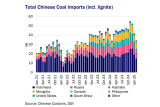
The new US administration has ushered the world into a new reality where renewed tariff barriers – or at least the threat of them – is quickly becoming the new normal. Both governments and companies are scrambling to adjust to the speed with which new threats are coming almost daily from the White House.
In his first month as the new president Donald Trump has managed to upend global trade using his favorite tool, tariffs. Among his first actions was to introduce 25% tariffs on imports from Canada and Mexico, while China got “only” 10% in addition to the existing tariff. The tariffs on the US’s neighbors were later postponed for a month after their leaders quickly intervened and promised concrete steps in fighting illegal immigration and fentanyl imports in the US. Imposing tariffs on Mexico and Canada whose economies are intertwined with the US would be disastrous for all involved countries, causing higher inflation and lower growth. As such, these tariffs may ultimately not happen – or at least not to that initially announced extent. To keep the pressure, the US may implement a gradual and escalating implementation of tariffs till it achieves the desired results and behavior from Mexico and Canada.
The latest iteration of the tariff theme is the so-called reciprocal tariffs. Reciprocal tariffs refer to tariffs—the taxes charged on imported goods—the U.S. government plans to levy against global trading partners that are equal to the existing tariffs foreign countries have set against American goods. Admittedly such an action will impact a broad range of products, among which will be also chemicals. Korea and Canada (again) may be in the crosshairs as the largest chemical exporters to the US.
One of the potential victims to reciprocal tariffs may be Brazilian ethanol. Brazil is the second-largest ethanol exporter in the world, after the US – and as such a tariff negotiation between the two countries will have an important impact on the global ethanol trade flows, regardless of the outcome.
Currently Brazil applies 18% import duty on US-origin ethanol while the US tariff on Brazilian ethanol stands at 2.5%. In 2024 the country exported about 250,000t to the US, but exports have been on a downtrend for the last couple of years. For the chemical tanker market this is much needed backhaul cargo flow on the otherwise poor trade lane from South America to US Gulf. On the other hand, almost no US ethanol was exported to Brazil which makes it a ripe target for a reciprocal tariff.
In a scenario where the US imposes also 18% tariff on Brazil-origin ethanol, this would mean that exports to the US will stop. It would add to the challenges for owners to return their ships back to the US Gulf, which may mean they would need to add higher premium on the southbound cargoes to compensate. But what could happen with this lost cargo flow to the US? Of course, the product will have to find other outlets and there are many potential ones. For example, Brazil is already the largest supplier of ethanol to South Korea with close to 650,000t in 2024. It also exported about 120,000t to the Netherlands and 75,000t to the Philippines. It also competes with the US for the Indian market which is expected to continue growing as the country progressively implements its ethanol mandate. These are all potential destinations which will increase the ton-mile demand – but possibly at the expense of long-haul ethanol exports from the US. Looking nearer to home, Brazil may be able to replace some of the US ethanol that is currently being exported to the Caribbeans. And finally maybe the easiest solution in this scenario is for Brazil itself to absorb the surplus volume by simply increasing its current mandate from 27% by another percentage point. This would also be aligned with the country’s long-term strategy to reduce its reliance on foreign fossil fuels.
A more likely scenario is that Brazil will balk and reduce the tariff rate on US ethanol – by how much remains to be seen. Will this see more US ethanol flowing south? Unlikely. Brazil – like the US – is a net exporter with large domestic production which is fully sufficient to satisfy its own demand. The cost of ethanol production in Brazil is slightly higher than the in the US (by about 6-7%), so in a situation where both countries apply the same tariff rate this cost difference may not be enough to cover the freight rate and leave some profit. The impact on chemical tanker shipping in this case may be more muddled. Theoretically, even though the tariffs on Brazilian ethanol may remain 2.5%, the US may impose non-tariff barriers or increase the already existing tax credit for local ethanol production and blending, thus effectively cutting out imports from Brazil. Here we’re back to the first scenario.
Trade wars are back and here to stay, with a wide-ranging and ever-changing implications, affecting many countries and products. In its announced reciprocal tariffs the US has marked Brazilian ethanol – it is an easy target, ripe for picking. The US can easily sacrifice ethanol imports from Brazil as the volume is not that high and can be replaced with domestic production, while declaring a win for US farmers and taxpayers. But the displaced ethanol volumes from Brazil may end up competing with US product for overseas markets and the net effect for the US may be close to zero. For shipping this will be yet another trade reconfiguration.
The new US administration has ushered the world into a new reality where renewed tariff barriers – or at least the threat of them – is quickly becoming the new normal. Both governments and companies are scrambling to adjust to the speed with which new threats are coming almost daily from the White House.
In his first month as the new president Donald Trump has managed to upend global trade using his favorite tool, tariffs. Among his first actions was to introduce 25% tariffs on imports from Canada and Mexico, while China got “only” 10% in addition to the existing tariff. The tariffs on the US’s neighbors were later postponed for a month after their leaders quickly intervened and promised concrete steps in fighting illegal immigration and fentanyl imports in the US. Imposing tariffs on Mexico and Canada whose economies are intertwined with the US would be disastrous for all involved countries, causing higher inflation and lower growth. As such, these tariffs may ultimately not happen – or at least not to that initially announced extent. To keep the pressure, the US may implement a gradual and escalating implementation of tariffs till it achieves the desired results and behavior from Mexico and Canada.
The latest iteration of the tariff theme is the so-called reciprocal tariffs. Reciprocal tariffs refer to tariffs—the taxes charged on imported goods—the U.S. government plans to levy against global trading partners that are equal to the existing tariffs foreign countries have set against American goods. Admittedly such an action will impact a broad range of products, among which will be also chemicals. Korea and Canada (again) may be in the crosshairs as the largest chemical exporters to the US.
One of the potential victims to reciprocal tariffs may be Brazilian ethanol. Brazil is the second-largest ethanol exporter in the world, after the US – and as such a tariff negotiation between the two countries will have an important impact on the global ethanol trade flows, regardless of the outcome.
Currently Brazil applies 18% import duty on US-origin ethanol while the US tariff on Brazilian ethanol stands at 2.5%. In 2024 the country exported about 250,000t to the US, but exports have been on a downtrend for the last couple of years. For the chemical tanker market this is much needed backhaul cargo flow on the otherwise poor trade lane from South America to US Gulf. On the other hand, almost no US ethanol was exported to Brazil which makes it a ripe target for a reciprocal tariff.
In a scenario where the US imposes also 18% tariff on Brazil-origin ethanol, this would mean that exports to the US will stop. It would add to the challenges for owners to return their ships back to the US Gulf, which may mean they would need to add higher premium on the southbound cargoes to compensate. But what could happen with this lost cargo flow to the US? Of course, the product will have to find other outlets and there are many potential ones. For example, Brazil is already the largest supplier of ethanol to South Korea with close to 650,000t in 2024. It also exported about 120,000t to the Netherlands and 75,000t to the Philippines. It also competes with the US for the Indian market which is expected to continue growing as the country progressively implements its ethanol mandate. These are all potential destinations which will increase the ton-mile demand – but possibly at the expense of long-haul ethanol exports from the US. Looking nearer to home, Brazil may be able to replace some of the US ethanol that is currently being exported to the Caribbeans. And finally maybe the easiest solution in this scenario is for Brazil itself to absorb the surplus volume by simply increasing its current mandate from 27% by another percentage point. This would also be aligned with the country’s long-term strategy to reduce its reliance on foreign fossil fuels.
A more likely scenario is that Brazil will balk and reduce the tariff rate on US ethanol – by how much remains to be seen. Will this see more US ethanol flowing south? Unlikely. Brazil – like the US – is a net exporter with large domestic production which is fully sufficient to satisfy its own demand. The cost of ethanol production in Brazil is slightly higher than the in the US (by about 6-7%), so in a situation where both countries apply the same tariff rate this cost difference may not be enough to cover the freight rate and leave some profit. The impact on chemical tanker shipping in this case may be more muddled. Theoretically, even though the tariffs on Brazilian ethanol may remain 2.5%, the US may impose non-tariff barriers or increase the already existing tax credit for local ethanol production and blending, thus effectively cutting out imports from Brazil. Here we’re back to the first scenario.
Trade wars are back and here to stay, with a wide-ranging and ever-changing implications, affecting many countries and products. In its announced reciprocal tariffs the US has marked Brazilian ethanol – it is an easy target, ripe for picking. The US can easily sacrifice ethanol imports from Brazil as the volume is not that high and can be replaced with domestic production, while declaring a win for US farmers and taxpayers. But the displaced ethanol volumes from Brazil may end up competing with US product for overseas markets and the net effect for the US may be close to zero. For shipping this will be yet another trade reconfiguration.
By Plamen Aleksandrov, Head of Research – Chemicals, SSY.
Articles
You may also be
interested in
View allGet in touch
Contact us today to find out how our expert team can support your business













